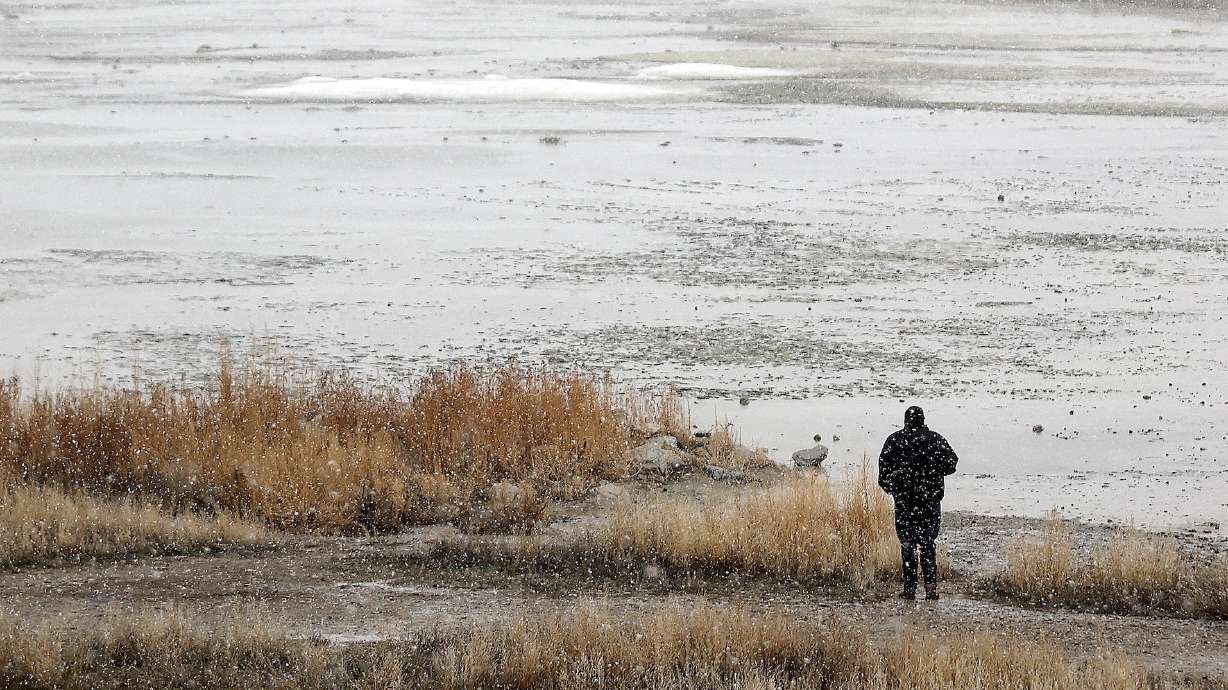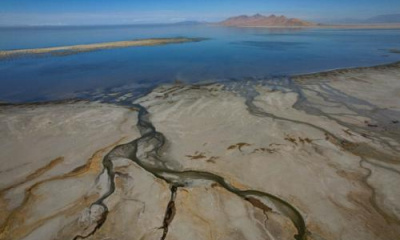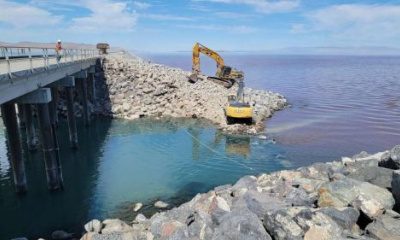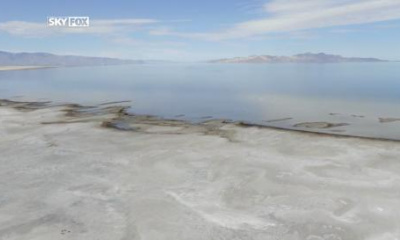SALT LAKE CITY — The Great Salt Lake's water levels are already as high as they were last year, and those who oversee its future now expect that at least half of the lake will reach a key metric in the coming weeks and months, as this year's snowpack accumulation melts.
The lake's southern arm has sat around 4,194.1 feet over the past week or two — the same height it peaked at last year. Its northern arm is up to 4,190.8 feet, which is higher than last year, per U.S. Geological Survey data updated on Wednesday.
It's positioned the lake in a "pretty good spot" for more gains this year, according to Brian Steed, Utah's Great Salt Lake commissioner.
"(It's) pretty awesome," he said. "It's great news because we have still not started the balance of our (snowpack) runoff and we have snow conditions that are above normal."
Exactly how much the Great Salt Lake rises this year is to be determined.
Estimating the lake's gains
The Natural Resources Conservation Service offered a ballpark guess earlier this month, estimating that it could gain another 1.2 feet by the end of the snowmelt. It's the first time the agency has projected an outlook for the lake after it began reporting snowpack collection and other data for the Great Salt Lake Basin this water year.
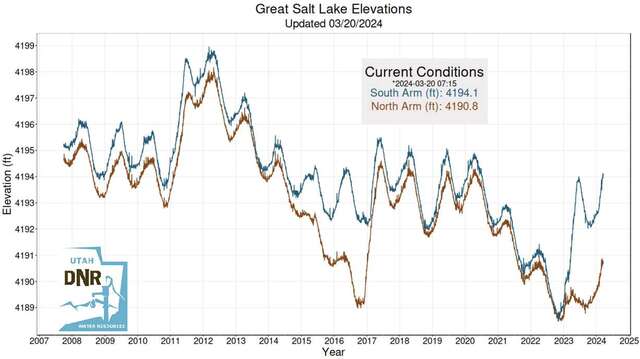
This graph, compiled by the Utah Department of Natural Resources, shows Great Salt Lake levels at the U.S. Geological Survey's Saltair and Saline stations between 2007 and Wednesday. (Photo: Utah Department of Natural Resources)
If that happens, at least the southern arm of the lake would reach 4,195 feet elevation for the first time in five years. It's one considered the halfway point between the lake's minimum healthy level — 4,198 feet elevation — and the trigger for serious adverse effects, which is anything below 4,192 feet elevation.
However, there are several caveats to the conservation service's projection, says Jordan Clayton, a hydrologist for the agency.
First, it's a conservative estimate and — as Clayton puts it — a "rough guidance" for those interested in the lake's health. It's primarily based on the middle outcome of the snowpack collected within the Great Salt Lake Basin, so inflows into the lake could be higher or lower than that projection depending on how efficient the snowmelt process is.
"In a really wide range of possible outcomes, it's the one in the middle ... but there's really a large amount of uncertainty there," he said, adding that it could be off by half a foot to 2 feet. "We don't want to be too specific about 1.2 (feet), or anything like that, because there's so many unknowns."
The basin's average snowpack — the amount of water within the snow that has fallen in the mountains — has slipped a little bit in recent days, from 21 inches of snow water equivalent on Sunday to 20.7 inches on Wednesday, but that is still 127% of the median for this time in the year and 106% of the median for the entire snow collection period. The snowpack collection season isn't over yet, so it could gain even more water in the coming weeks.
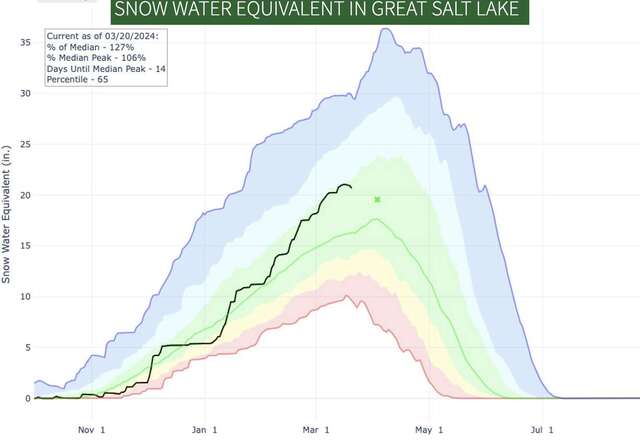
This graph shows the average mountain snowpack within the Great Salt Lake Basin this year (black line) compared the normal (green line) and other points in recent history. This year's collection is already above the median peak dating back to 1981. (Photo: Natural Resources Conservation Service)
The projection also doesn't take into account a few other unknowns. Clayton said the conservation service doesn't have access to water management plans, so it doesn't consider possible additions and subtractions to the lake's inflows.
This means more water could end up in the lake if water managers within the basin decide to release water from reservoirs to avoid flooding concerns. It happens anytime the amount of water in the mountain snowpack is projected to exceed the amount of storage space available in a reservoir.
The Great Salt Lake is in a good position to gain water from controlled releases because many reservoirs within the basin are already at or near full capacity before the spring snowmelt. Utah Lake and a handful of other reservoirs have already started the process, said deputy Great Salt Lake commissioner Tim Davis.
"We've been communicating with all the district throughout the winter about what they're releasing and when they're releasing," he said.
Yet less water could end up in the lake if warmer and drier conditions this spring ruin the snowmelt efficiency and also launch the irrigation season early. Experts point out that water consumption upstream of the lake accounts for about 67% to 73% of the lake's decline.
The outlook also doesn't take into account that the lake is split in half right now. Water levels are drastically different at the northern and southern arms because of a berm that was raised in 2022 to prevent higher salinity levels in the northern arm, and it's expected that most of this year's gains will be in the southern arm again.
While the southern arm's conditions have improved, there are also no plans to lower the berm anytime soon. Ben Stireman, deputy director at the Utah Division of Forestry, Fire and State Lands, said water is flowing "pretty strongly through the breach" in the Great Salt Lake Causeway, and biologists also believe there's a benefit to keeping the berm in place for now.
"What we've seen is that it's better to hold (water) in the south arm and give it some time to mix before it goes into the north arm, so we can export as much salt as possible to the north arm," he said, adding the agency could reevaluate the berm height after this year's runoff.
Summer dropoff
The lake will drop again this summer, as it normally does, but it's also unclear how much it will lose. That's dependent on several factors, including consumption of its tributaries and evaporation.
But if the projection holds up, Steed says reaching or exceeding 4,195 feet elevation in the south arm anytime this year would be an "important" feat. It's the "next band" in the recovery tiers that his office set up in a recent strategic plan.
It indicates that the lake is improving after falling to a record low in 2022.
"It's still not healthy, but it's closer to healthy than we have been anytime since 2019," Steed said. "We're really happy to (potentially) get there this year."

